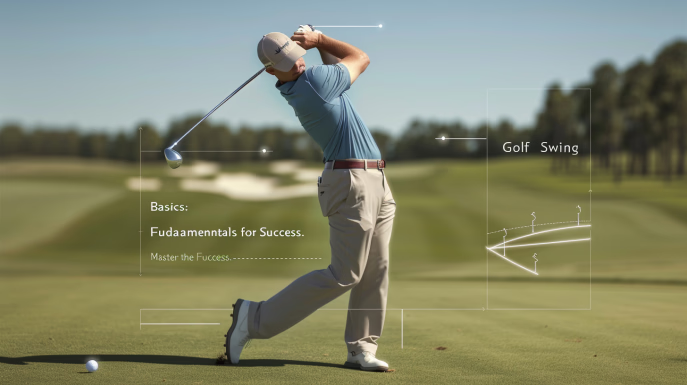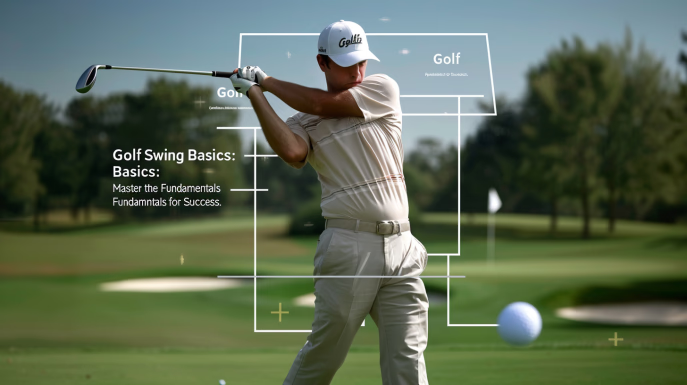Golf Swing Basics: Master the Fundamentals for Success

Source : pinnaclegolfpros copyright
Mastering the game of golf requires a deep understanding of the essential swing fundamentals. This comprehensive article provides a detailed exploration of the golf swing basics that every player, from beginner to seasoned professional, needs to conquer for consistent success on the course. From the proper grip, stance, and posture to the intricate mechanics of the backswing, downswing, and follow-through, this guide covers the fundamental elements that form the foundation of a sound golf swing.
Golfers will learn proven techniques and targeted drills to refine their swing and unlock improvements in consistency, accuracy, power, and distance. Whether you’re just starting your golfing journey or an experienced player seeking to fine-tune your skills, this article will equip you with the knowledge and tools to take your game to new heights. Dive in and master the golf swing basics for a lifetime of golfing excellence.
Key Takeaways
- Understand the importance of proper golf swing fundamentals for consistent and successful play.
- Discover techniques to develop a reliable grip, stance, and posture for a solid foundation.
- Learn the mechanics of the backswing, downswing, and follow-through for a more powerful and controlled swing.
- Explore targeted drills and practice methods to ingrain the golf swing basics into your muscle memory.
- Gain the knowledge and confidence to continuously improve your swing and take your game to new levels.
Understanding the Golf Swing: A Comprehensive Guide

The golf swing is a complex and intricate motion that requires a deep understanding of proper technique and the role of swing fundamentals. This section of the article delves into the essential elements that contribute to a consistent and accurate golf swing, setting the stage for the more detailed techniques explored in the subsequent sections.
The Importance of Proper Technique
Mastering the fundamentals of the golf swing is paramount for achieving long-term success on the course. From the grip and stance to the mechanics of the backswing, downswing, and follow-through, each component plays a crucial role in developing a reliable and repeatable swing. By focusing on proper technique, golfers can build a solid foundation that enables them to execute consistent and accurate shots, regardless of their skill level.
The Role of Swing Fundamentals
The golf swing is built upon a foundation of key fundamentals, including grip, stance, posture, weight distribution, and body mechanics. These elements work in tandem to create a fluid and efficient swing that generates power, control, and consistency. Understanding the interplay of these fundamentals is essential for developing a golf swing that performs reliably under various conditions and challenges.
Achieving Consistency and Accuracy
Consistency and accuracy are the hallmarks of a well-executed golf swing. By mastering the swing basics and developing a deep understanding of the underlying mechanics, golfers can consistently strike the ball with precision, leading to improved shot outcomes, lower scores, and greater enjoyment on the course. This section lays the groundwork for the specific techniques and drills that will be covered in the subsequent sections, empowering readers to take their golf game to new heights.
Mastering the Grip: The Foundation of a Solid Swing
The grip serves as the critical foundation for a reliable and consistent golf swing. In this section, we will explore the essential grip fundamentals, focusing on the two most prominent grip styles – the overlapping grip and the interlocking grip. Additionally, we will emphasize the importance of finding the perfect grip pressure, a delicate balance between a firm hold and a relaxed wrist and forearm.
Grip Fundamentals: The Overlapping and Interlocking Grips
The overlapping grip, also known as the Vardon grip, is a popular choice among golfers of all skill levels. This grip style involves placing the little finger of the dominant hand on top of the index finger of the non-dominant hand, creating a seamless connection between the hands. The interlocking grip, on the other hand, features the little finger of the dominant hand interlocking with the index finger of the non-dominant hand. Both grip styles offer unique benefits, and the choice ultimately depends on individual preference and the specific needs of a golfer’s swing.
Grip Pressure: Finding the Perfect Balance
Alongside the grip style, the amount of pressure applied to the club is a critical factor in achieving a consistent and reliable swing. Golfers must find the perfect balance, applying enough pressure to maintain control of the club while avoiding a grip that is too tight, which can restrict the natural movement of the wrists and forearms. By developing a consistent grip pressure, golfers can unlock the full potential of their swing, generating power while maintaining the necessary control and stability.
| Grip Style | Benefits | Proper Execution |
|---|---|---|
| Overlapping Grip (Vardon Grip) |
|
|
| Interlocking Grip |
|
|
By mastering the fundamentals of the golf grip and finding the perfect balance of grip pressure, golfers can establish a solid foundation for their swing and unlock their full potential on the course. Whether you prefer the overlapping grip or the interlocking grip, developing a consistent and reliable grip is a crucial step towards improving your golf swing and achieving greater success in the game.
The Stance: Setting the Stage for Success

The golf stance is the foundation upon which the entire swing is built. Establishing a solid, balanced stance is crucial for golfers to execute consistent and accurate shots. This section delves into the key elements of the proper golf stance, including stance width, alignment, weight distribution, and balance.
Stance Width and Alignment
The width of a golfer’s stance plays a significant role in their swing stability and shot direction. A stance that is too narrow can lead to a loss of balance and control, while a stance that is too wide can restrict the swing’s natural motion. The optimal stance width is generally shoulder-width, with the feet positioned slightly wider than the hips. This stance width allows for a stable base while still providing the necessary flexibility and mobility to rotate through the swing.
Proper alignment is equally important in the golf stance. The player’s body should be parallel to the target line, with the shoulders, hips, and feet all pointing in the same direction. Ensuring accurate alignment helps the golfer swing the club on the intended path, leading to straighter and more accurate shots.
Weight Distribution and Balance
Effective weight distribution and balance are essential for generating power and maintaining control throughout the golf swing. Golfers should aim to have their weight evenly distributed between the balls of their feet, with a slight bias towards the lead foot (left foot for right-handed players) during the address position. This weight distribution allows for a smooth weight shift and transfer of power during the swing.
Maintaining balance is crucial for consistent ball striking. Golfers should feel a stable, centered stance with their weight centered over the middle of their feet. Avoiding excessive sway or swaying during the swing can help maintain this balanced position, leading to more repeatable and reliable shots.
Posture: The Key to Unleashing Power
Proper golf posture is essential for unleashing power and maintaining control in the golf swing. This section focuses on the importance of maintaining the correct golf spine angle and knee flex to establish an athletic posture and balanced stance. It explains how these postural elements contribute to an efficient and powerful swing, allowing golfers to generate maximum clubhead speed while maintaining stability and balance.
Maintaining Proper Spine Angle
The golf swing basics emphasize the need for a neutral spine angle throughout the swing. Maintaining the correct spine tilt, with the shoulders slightly hunched forward and the lower back in a slight arch, helps to create a stable foundation for the swing. This ideal golf spine angle allows for efficient energy transfer from the ground, up through the body, and into the clubhead, resulting in greater golf power and distance.
Knee Flex and Athletic Posture
In addition to spine angle, the amount of knee flex plays a crucial role in establishing an athletic posture for the golf swing. By maintaining a slight bend in the knees and a neutral pelvic tilt, golfers can achieve a balanced and centered stance that facilitates smooth weight transfer and body rotation. This golf fundamentals-based approach enables golfers to generate clubhead speed while maintaining control and stability throughout the swing techniques.
Readers will learn techniques to develop the optimal golf posture for their swing, setting the stage for consistent and successful shots on the course. By mastering these golf instruction and golf lessons on proper posture, golfers can unlock their full potential and experience the benefits of a powerful, balanced, and consistent golf coaching approach.
The Backswing: Building Momentum
The backswing is the crucial first step in generating power and momentum for the golf swing. This section delves into the mechanics of the golf backswing, highlighting the importance of weight shift and body rotation. It also explores the proper positioning of the arms and wrists, essential elements that contribute to a smooth and efficient backswing.
Weight Shift and Body Rotation
Initiating the backswing with a gradual shift of weight from the front foot to the rear foot is a fundamental technique that lays the foundation for a powerful swing. As the weight shifts, the body rotation should follow, allowing the shoulders and hips to turn away from the target. This synchronized movement creates the necessary coil and stored energy that can be unleashed in the downswing.
Arm and Wrist Positioning
The positioning of the arms and wrists during the backswing plays a crucial role in maintaining control and consistency. Golfers should focus on keeping their arms relaxed and their wrists in a neutral position, avoiding excessive cupping or bowing. This optimal arm and wrist posture helps establish a balanced and repeatable golf swing, setting the stage for a powerful and controlled downswing.
The One-Piece Takeaway
The concept of the “one-piece takeaway” emphasizes the synchronized movement of the arms, hands, and club during the initial phase of the backswing. By keeping the club, arms, and hands working together as a single unit, golfers can achieve a smooth and efficient golf backswing that sets the stage for a powerful downswing. Mastering this technique helps golfers develop a consistent swing path and swing plane, ultimately leading to more accurate and consistent ball striking.
The Downswing: Unleashing Power
The downswing is the pivotal moment where golfers unleash their power and generate club head speed. This crucial phase of the golf swing requires a harmonious integration of weight transfer and hip rotation to maximize power and control.
Weight Transfer and Hip Rotation
As the golfer transitions from the backswing to the downswing, proper weight transfer is essential. The player should shift their weight smoothly from the trailing foot to the leading foot, allowing the hips to rotate and the body to unwind. This weight shift and hip rotation generate the necessary torque and momentum to propel the club through the hitting zone with authority.
Arm and Wrist Uncocking
Simultaneously with the weight transfer and hip rotation, the golfer’s arms and wrists must uncock in a coordinated manner. The arms should release naturally, allowing the club to accelerate through the ball. The wrists should also uncock, providing a final burst of power and clubhead speed. This seamless integration of the body and the club during the downswing is the key to unlocking maximum power and delivering a consistent, powerful strike.
By mastering the techniques of weight transfer, hip rotation, arm uncocking, and wrist uncocking, golfers can develop a downswing that maximizes their power output while maintaining control and accuracy. This section provides valuable insights and practical drills to help golfers refine these critical elements of the golf swing.
The Impact: The Moment of Truth

The impact moment is where the golf swing reaches its climax, determining the outcome of the shot. This section delves into the critical factors that contribute to a solid and accurate impact, including clubface alignment and squaring, as well as the importance of center contact and ball compression. Golfers will learn techniques to ensure their clubface is correctly positioned at impact, allowing them to achieve greater consistency, distance, and control over their shots.
Clubface Alignment and Squaring
Proper clubface alignment and squaring at the point of impact are essential for achieving accurate and consistent ball flight. Golfers must learn to consistently square the clubface to the target line, ensuring the club’s sweet spot makes full contact with the ball. This critical component of the golf swing fundamentals allows players to optimize launch conditions, minimize hooks and slices, and maximize distance and control.
Center Contact and Compression
Achieving center contact on the clubface is crucial for maximizing ball compression and generating optimal launch conditions. Golfers should focus on making solid, centered contact with the ball, which enables the transfer of energy and produces a more penetrating, consistent ball flight. Techniques to improve center contact and ball compression can significantly enhance a player’s swing techniques and overall golf performance.
The Follow-Through: Completing the Swing
The follow-through is the final, often overlooked, phase of the golf swing. This section emphasizes the importance of the follow-through, highlighting the role of balance and weight transfer in maintaining control and stability. It also explores the optimal finishing position, demonstrating how a well-executed follow-through can reinforce the swing mechanics and lead to more consistent and powerful shots.
Balance and Weight Transfer
Maintaining balance and effecting a smooth weight transfer are crucial elements of the follow-through. As the clubhead reaches the conclusion of the swing, the golfer’s body must remain centered and poised, with the weight evenly distributed between the feet. This balanced posture not only enhances control but also allows the player to seamlessly transition into their next shot.
Finishing Position
The finishing position of the golf swing is a reflection of the entire swing’s execution. A well-balanced and fluid follow-through will guide the golfer into an optimal finishing stance, with the weight shifted towards the target and the club pointing in the desired direction. This finishing position reinforces the proper swing mechanics, setting the stage for consistent and powerful shots in the future.
By mastering the techniques of a proper follow-through, golfers can develop a golf swing that is not only efficient but also visually appealing. The seamless completion of the swing, with a focus on balance and weight transfer, will lead to a finishing position that exudes control and confidence, ultimately translating to improved performance on the course.
Golf Swing Basics: Essential Drills and Practice Techniques
Mastering the fundamentals of the golf swing requires consistent practice and the implementation of targeted drills. This section provides a comprehensive set of essential techniques to help golfers refine their grip, stance, swing plane, swing path, tempo, and rhythm.
Grip and Stance Drills
Developing a proper grip and stable stance is the foundation of a reliable golf swing. Golfers can practice grip drills, such as the “Grip Pressure Test” and “Grip Squeeze,” to ensure they maintain the ideal grip pressure and hand positioning. Stance drills, including the “Feet-Together Swing” and “Weight Shift Drill,” will help golfers establish a balanced and aligned stance that supports a consistent swing.
Swing Plane and Path Drills
Maintaining an efficient swing plane and optimal swing path is crucial for consistent ball striking. Drills like the “Hula Hoop Drill” and “Alignment Rods Drill” can help golfers groove a swing that travels on the proper plane and follows the target line. By mastering these swing fundamentals, players can achieve greater accuracy and ball control.
Tempo and Rhythm Drills
Developing a consistent swing tempo and smooth rhythm is essential for generating power and repeatability. Golfers can practice tempo drills, such as the “Metronome Drill” and “Slow-Motion Swing,” to ingrain a balanced and rhythmic swing. Rhythm drills, including the “Pendulum Swing” and “Tapping Drill,” will help players establish a fluid and synchronized swing pattern.
By incorporating these practice techniques into their routine, golfers can make measurable improvements in their swing mechanics and overall game performance. Consistent and focused practice on the fundamental elements of the golf swing is the key to developing a reliable and efficient swing that delivers greater consistency, accuracy, and distance.
Swing Tempo: Finding the Right Rhythm
The golf swing tempo is a critical element in achieving a consistent and efficient golf swing. This section emphasizes the importance of developing a balanced and consistent swing tempo, as it directly impacts power, control, and overall shot quality. By understanding the significance of swing tempo and learning techniques to maintain a steady rhythm, golfers can unlock greater repeatability and consistency in their swings, leading to more accurate and powerful shots.
The Importance of Tempo
A well-paced golf swing rhythm is essential for generating power, maintaining control, and promoting consistency in your game. When the swing tempo is out of sync, it can lead to inconsistent ball striking, erratic shot trajectories, and a loss of distance. Conversely, a consistent swing tempo allows golfers to develop muscle memory and execute their swing with a fluid and repeatable motion, resulting in more accurate and powerful shots.
Developing a Consistent Tempo
Mastering consistent swing tempo takes practice and dedication, but the rewards are well worth the effort. Golfers can develop a consistent swing rhythm by focusing on the timing and rhythm of their swing, rather than solely on the speed. Implementing drills that emphasize a smooth and rhythmic motion, such as tempo-based exercises or metronome-guided practice, can help golfers find their optimal swing tempo and maintain it throughout the swing.
By investing time in improving their golf swing tempo and rhythm, golfers can unlock a new level of performance on the course. With a consistent and well-paced swing, players can expect to experience greater accuracy, distance control, and overall shot consistency, ultimately leading to lower scores and more enjoyment on the golf course.
Ball Position: Optimizing Impact
The placement of the golf ball in relation to the player’s stance, known as ball position, is a crucial factor in optimizing the impact and trajectory of the shot. Understanding proper ball position and how it varies for different club selections is essential for achieving consistent and reliable ball striking, leading to improved accuracy, distance control, and overall performance.
Understanding Ball Position
The ball position refers to the location of the golf ball relative to the player’s feet. Proper ball position is crucial for ensuring the club makes optimal contact with the ball at the moment of impact. By adjusting the ball position, golfers can influence factors such as launch angle, spin rate, and shot trajectory, ultimately leading to more accurate and controlled shots.
Adjusting for Different Clubs
The optimal ball position will vary depending on the type of club being used. As a general guideline, the ball should be positioned slightly forward (closer to the target) for longer clubs, such as drivers and woods, and slightly back (closer to the player) for shorter clubs, such as irons and wedges. This adjustment helps golfers achieve the desired ball flight and maximize the performance of each club in their arsenal.
By mastering the art of ball position adjustment, golfers can ensure consistent and reliable ball striking, leading to improved accuracy, distance control, and overall performance on the golf course.
Club Face Control: The Key to Accuracy
Maintaining control over the golf club’s face at impact is essential for achieving accuracy and consistent ball striking. The alignment and squaring of the clubface at the moment of impact play a crucial role in determining the direction and trajectory of your shots. By mastering the ability to consistently square the clubface, golfers can experience greater consistency in their shot patterns, ultimately leading to improved accuracy and lower scores on the course.
Square Clubface at Impact
Ensuring the clubface is square at impact is a fundamental principle of accurate ball striking. When the clubface is aligned properly and squared at the point of contact, the ball will launch straight and true, following the intended target line. This requires precise control over the club’s orientation throughout the swing, from the backswing to the follow-through.
Golfers must develop a keen awareness of their clubface alignment and learn to consistently square the clubface at the moment of impact. This involves fine-tuning their swing mechanics, such as grip pressure, wrist hinge, and body rotation, to ensure the clubface remains in the optimal position at the critical impact phase.
Drills for Improving Club Face Control
To help golfers improve their club face control, there are several effective drills and practice techniques that can be incorporated into their training regimen. These include:
- Alignment Sticks Drill: Place an alignment stick parallel to your target line and position another stick perpendicular to it, just behind the ball. Focus on keeping the clubface square to the perpendicular stick throughout your swing.
- Impact Bag Drill: Hit shots into an impact bag, which provides immediate feedback on your clubface alignment at impact. Adjust your swing mechanics until you can consistently strike the bag with a square clubface.
- Mirror Drill: Practice your swing in front of a mirror, paying close attention to the clubface position at the top of the backswing and at impact. Make adjustments to ensure the clubface remains square throughout the swing.
- Tee Placement Drill: Place a tee just outside the heel of your club and try to strike the ball without moving the tee. This drill helps develop a sense of clubface control and stability at impact.
By incorporating these drills into your practice routine, you can develop a greater understanding of clubface control and the ability to consistently square the clubface at impact. This mastery of club face control will be the key to unlocking greater accuracy and consistency in your golf game.
Weight Transfer: Unlocking Power and Balance
Effective weight transfer is a fundamental component of a powerful and balanced golf swing. This section emphasizes the importance of proper weight shift throughout the swing, from the backswing to the follow-through. Mastering the art of weight transfer can unlock greater power, stability, and consistency in your game.
The Importance of Weight Shift
The golf swing is a dynamic movement that requires a seamless transfer of weight from one side of the body to the other. During the backswing, the weight should shift to the rear foot, allowing for a full rotation of the hips and shoulders. As you transition into the downswing, the weight should then shift back to the front foot, generating the necessary momentum and power to strike the ball with authority. Proper weight transfer ensures that you maintain balance and control throughout the swing, preventing unwanted movement or loss of stability.
Drills for Proper Weight Transfer
To help golfers develop a consistent and efficient weight transfer, here are some effective drills to incorporate into your practice routine:
- Foot Pressure Drill: Set up to the ball with your weight evenly distributed on both feet. As you take the club back, consciously shift your weight to your rear foot, feeling the pressure increase in that foot. On the downswing, feel the weight transfer back to the front foot, ensuring a smooth and balanced transition.
- Torso Rotation Drill: Stand with your feet shoulder-width apart and your weight evenly distributed. As you take the club back, focus on rotating your torso and hips while maintaining your balance. On the downswing, feel the weight shift to your front foot as you uncoil your body, generating power through your swing.
- Balance Board Drill: Perform your swing while standing on a balance board or other unstable surface. This will challenge your ability to maintain balance and control throughout the swing, reinforcing the importance of proper weight transfer.
By incorporating these drills into your practice routine, you’ll develop a better understanding of the weight shift dynamics and learn to execute a more powerful, balanced, and consistent golf swing.
Golf Swing Basics: Putting It All Together
This final section focuses on the importance of seamlessly integrating all the individual swing fundamentals covered in the previous sections into a cohesive and consistent golf swing. By mastering the integration of these core elements, players can take their game to new heights and achieve long-term success on the course.
Integrating the Fundamentals
Developing a reliable and efficient golf swing requires a holistic approach, where the various components – such as grip, stance, posture, backswing, downswing, and follow-through – work in harmony. This section provides guidance on how to blend these fundamental elements into a repeatable swing pattern that delivers accurate, powerful, and controlled shots.
Golfers will learn techniques to synchronize their movements, building muscle memory and a deep understanding of how each part of the swing contributes to the overall performance. By mastering the integration of the golf swing fundamentals, players can unlock their full potential and enjoy greater consistency, accuracy, and distance on the course.
Building Consistent Swing Patterns
Consistency is the hallmark of a well-executed golf swing, and this section explores strategies for developing consistent swing patterns. Golfers will discover drills and practice methods that reinforce the integrated golf swing, allowing them to repeatedly execute shots with precision and control.
Through dedicated practice and a commitment to the golf swing basics and fundamentals, players can ingrain the proper mechanics and optimize their golf performance. This section empowers golfers to take their game to new levels by fostering a consistent, reliable swing that withstands the demands of the course.
Conclusion: Mastering the Fundamentals for Long-Term Success
As this comprehensive guide on golf swing fundamentals comes to a close, it’s crucial to emphasize the importance of mastering the essential elements for achieving lasting success on the golf course. By thoroughly understanding and consistently applying the techniques and drills covered throughout this article, golfers can develop a reliable and efficient golf swing that delivers greater consistency, accuracy, power, and distance.
The journey of golf swing mastery is an ongoing process, and golfers are encouraged to continually refine their mechanics, practice with purpose, and embrace the process of continuous improvement. By committing to the fundamentals, players can unlock their full potential and enjoy the game of golf at the highest level. Consistent practice and a dedication to perfecting the basics will be the foundation for long-term golf improvement and enhanced golf performance.
Remember, the key to unlocking your best golf game lies in mastering the fundamentals. Stay committed to your practice, embrace the process, and trust that the techniques and drills outlined in this article will help you develop a golf swing that stands the test of time. Embrace the journey, celebrate your progress, and enjoy the thrill of seeing your golf consistency, accuracy, and distance soar to new heights.
FAQ
What are the key elements of a proper golf grip?
The two most common grip styles are the overlapping grip and the interlocking grip. Regardless of the grip, it’s important to find the perfect balance of grip pressure, ensuring a firm yet relaxed hold on the club.
How do I establish the correct golf stance?
A proper golf stance involves finding the optimal width and alignment, as well as maintaining proper weight distribution and balance. These factors work together to create a stable foundation for your swing.
What is the importance of posture in the golf swing?
Maintaining the correct spine angle and knee flex is crucial for developing an athletic and balanced posture. This posture allows you to generate power while maintaining control throughout the swing.
How do I execute a proper backswing?
The backswing involves a weight shift, body rotation, and the correct positioning of your arms and wrists. The “one-piece takeaway” technique helps synchronize these movements for a smooth and efficient backswing.
What are the key elements of an effective downswing?
The downswing is characterized by a weight transfer, hip rotation, and the uncocking of the arms and wrists. Mastering these movements is essential for unleashing power and generating club head speed.
How important is the follow-through in the golf swing?
The follow-through plays a vital role in maintaining balance and transferring weight effectively. A well-executed follow-through can reinforce the swing mechanics and lead to more consistent and powerful shots.
What are some essential drills for improving golf swing basics?
Targeted drills focused on the grip, stance, swing plane, swing path, tempo, and rhythm can help reinforce the fundamental elements of the golf swing and develop muscle memory for more consistent performance.
How can I develop a consistent swing tempo?
Achieving a balanced and consistent swing tempo is crucial for power, control, and overall shot quality. Techniques such as practicing with a metronome or focusing on a smooth, rhythmic swing can help golfers find their optimal tempo.
How does ball position affect my golf swing?
Ball position plays a significant role in optimizing impact and shot trajectory. Adjusting the ball position based on the club selection can help golfers achieve optimal launch conditions and improve their overall ball striking.
Why is clubface control important for accuracy?
Maintaining control over the clubface at the moment of impact is essential for achieving consistent accuracy and ball flight. Drills focused on squaring the clubface can help golfers develop this critical skill.

